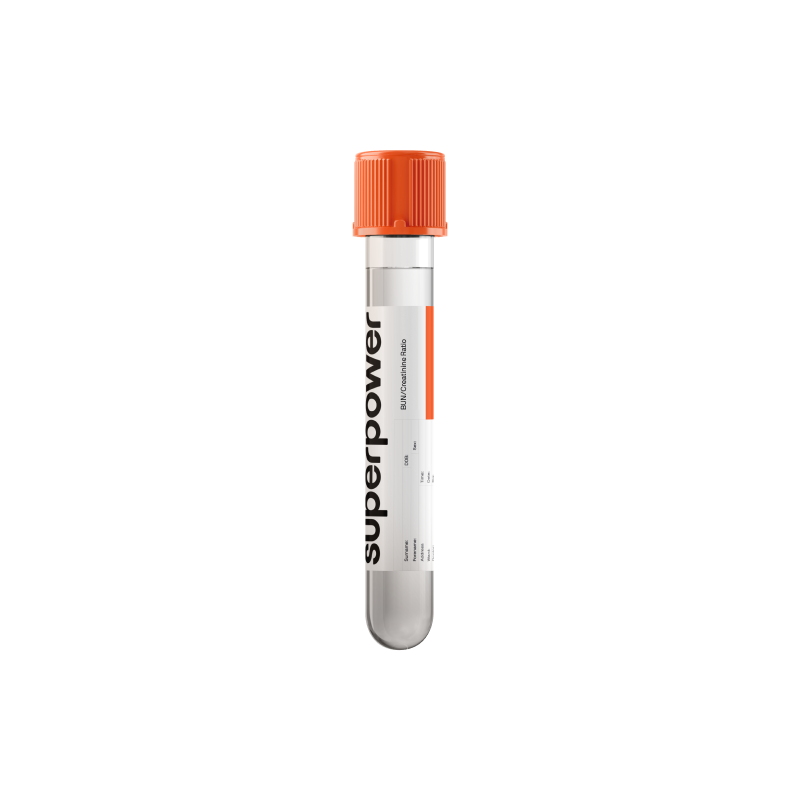BUN/Creatinine Ratio testing adds context beyond individual markers, helping differentiate dehydration from intrinsic kidney issues, track protein balance, and guide smarter recovery, nutrition, and training choices.
Key Benefits
- Spot dehydration versus kidney damage using your BUN-to-creatinine balance.
- Clarify a creatinine rise by flagging dehydration or bleeding in the gut.
- Flag high protein intake or tissue breakdown when the ratio skews upward.
- Suggest liver disease or poor nutrition when low urea lowers the ratio.
- Guide next steps by distinguishing low kidney blood flow from kidney tissue injury.
- Explain symptoms like dizziness, low urine, or confusion tied to dehydration.
- Track recovery after fluids, illness, or surgery by watching the ratio normalize.
- Best interpreted with eGFR, urinalysis, vital signs, and your symptoms.
What is BUN/Creatinine Ratio?
The BUN/Creatinine Ratio compares two natural waste products in the blood: urea and creatinine. Urea comes from the liver’s conversion of ammonia produced during protein breakdown (blood urea nitrogen, BUN; urea cycle). Creatinine comes from routine muscle energy use (from creatine phosphate) and is produced at a fairly steady rate. Both are cleared by the kidneys—urea is filtered and variably reabsorbed, while creatinine is filtered and only minimally secreted.
This ratio captures how these two wastes behave relative to each other and to kidney handling. It reflects kidney filtration (glomerular filtration), water balance and hormonal signals that change urea reabsorption (antidiuretic hormone, ADH), liver protein metabolism, and baseline muscle mass. Because urea is more influenced by hydration and protein turnover, and creatinine is more anchored to muscle production, their ratio helps translate a raw “waste load” into a physiological snapshot. In short, the BUN/Creatinine Ratio contextualizes kidney-related measurements by showing whether changes are driven more by fluid status and protein metabolism (affecting BUN) or by the steadier muscle-derived signal (creatinine).
Why is BUN/Creatinine Ratio important?
The BUN/Creatinine ratio compares two wastes your body makes and clears every minute: urea nitrogen from protein metabolism (made by the liver, excreted by the kidneys) and creatinine from muscle energy use (filtered by the kidneys). Because it bridges liver function, muscle mass, kidney filtration, and blood flow, it helps sort out why kidney numbers are off and whether the issue is hydration, perfusion, catabolism, or bleeding. Most labs consider roughly 10–20 typical, with “healthy” patterns usually sitting in the middle.
When the ratio drifts low (often below about 10), it means urea is relatively low or creatinine is relatively high. This points to reduced hepatic urea production (advanced liver disease, severe low protein intake) or a creatinine rise from muscle injury or intrinsic kidney damage such as acute tubular necrosis. People may notice fatigue, swelling, jaundice, muscle pain, or cola‑colored urine. Children and pregnancy tend to have lower absolute BUN and creatinine, but a genuinely low ratio carries similar meaning.
When the ratio runs high (often above about 20), BUN is disproportionately elevated. That commonly reflects reduced kidney blood flow from dehydration or heart failure, increased protein breakdown or intake, corticosteroid effect, or digestion of blood from an upper GI bleed. Clues include thirst, dizziness, dry mouth, low urine, black stools, or pallor.
Big picture: this ratio is a lens on the liver–muscle–kidney circuit and on circulatory status. Interpreted alongside the actual BUN, creatinine, and eGFR, it helps distinguish prerenal strain from intrinsic renal injury, flags catabolic stress or bleeding, and, when persistently abnormal, signals risks for progressive kidney or liver complications.
What Insights Will I Get?
The BUN/Creatinine Ratio compares two waste products—urea nitrogen from protein metabolism (made in the liver) and creatinine from muscle metabolism (released at a steady rate). Because both are filtered by the kidneys, their balance reflects nitrogen handling, muscle turnover, and kidney blood flow. This makes the ratio a window into metabolic state, hydration and perfusion, and how well the liver–kidney axis is coordinating waste removal.
Low values usually reflect less urea relative to creatinine. This can occur with reduced hepatic urea production (impaired urea cycle or significant liver dysfunction) or low protein availability, or with higher creatinine from greater muscle mass or accelerated muscle breakdown. Systemically, it points to altered nitrogen processing or disproportionate muscle turnover. Lower ratios are more common in muscular younger adults and less common in children.
Being in range suggests balanced protein catabolism and muscle turnover, healthy hepatic urea production, and adequate renal perfusion with normal tubular handling. In practice, the ratio tends to sit near the middle when both BUN and creatinine are individually normal.
High values usually reflect increased urea relative to creatinine. Typical drivers are reduced kidney blood flow with enhanced urea reabsorption (prerenal azotemia), increased protein breakdown or load, or occult gastrointestinal bleeding. Older age and lower muscle mass can raise the ratio by lowering creatinine.
Notes: Interpret the ratio alongside the absolute BUN and creatinine values and recent illness. Hydration status, acute cardiovascular stress, high catabolic states, and certain drugs (e.g., glucocorticoids) influence it. Age, sex, and muscle mass shift creatinine; pregnancy lowers both BUN and creatinine and uses trimester-specific reference ranges.



.svg)



.png)
.png)
.png)
.png)








